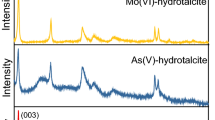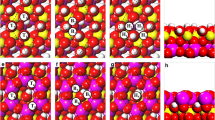Abstract
Arsenic is an environmentally ubiquitous health hazard due to its toxicity combined with its natural abundance and heavy industrial applications. Due to its role in cardiovascular disease, neurotoxicity, and various cancers, it is important to understand environmental fate of arsenic-containing compounds to take steps towards remediation. Sodium arsenite (NaAsO2) is one such compound that has been used worldwide as an herbicide, rodenticide, and insecticide. It is also toxic by ingestion, inhalation, and skin absorption. In aqueous environments, arsenite (As(III))-containing compounds can be oxidized to the less-toxic arsenate (As(V)) form. We have investigated the oxidation of sodium arsenite in water solution at the density functional theory level using the Minnesota 06 hybrid (M06-2X) functional and Pople basis sets (6-31G(d,p) and 6-311G(d,p)) with polarizable continuum model (PCM) solvation approach. Our computational results indicate that the oxidation mechanism of NaAsO2 by hydroxyl radical proceeds via sequential addition reactions where sodium arsenite (III) converts to sodium arsenate (V) via an arsenic (IV) intermediate.


Similar content being viewed by others
Availability of data and material
The datasets generated during and/or analyzed during the current study are available from the corresponding author on reasonable request.
References
Mandal BK, Suzuki KT (2002) Arsenic round the world: a review. Talanta 58:201–235. https://doi.org/10.1016/S0039-9140(02)00268-0
Flora SJS (2015) Arsenic: chemistry, occurrence, and exposure. In: Handbook of Arsenic Toxicology. Elsevier, pp 1–49
Hassan MM (2018) Arsenic in groundwater: poisoning and risk assessment, 1st edn. CRC Press, Boca Raton
Ravenscroft P, Brammer H, Richards K (2009) Arsenic pollution: a global synthesis. Wiley-Blackwell, Oxford, UK
US EPA (2002) Arsenic treatment technologies for solid, waste, and water
Ghosh (Nath) S, Debsarkar A, Dutta A (2019) Technology alternatives for decontamination of arsenic-rich groundwater—a critical review. Environ Technol Innov 13:277–303. https://doi.org/10.1016/j.eti.2018.12.003
Mondal P, Majumder CB, Mohanty B (2006) Laboratory based approaches for arsenic remediation from contaminated water: recent developments. J Hazard Mater 137:464–479. https://doi.org/10.1016/j.jhazmat.2006.02.023
Bundschuh J, Bhattacharya P, Sracek O et al (2011) Arsenic removal from groundwater of the Chaco-Pampean plain (Argentina) using natural geological materials as adsorbents. J Environ Sci Health A 46:1297–1310. https://doi.org/10.1080/10934529.2011.598838
Singh R, Singh S, Parihar P et al (2015) Arsenic contamination, consequences and remediation techniques: a review. Ecotoxicol Environ Saf 112:247–270. https://doi.org/10.1016/j.ecoenv.2014.10.009
Han L, Gao B, Hao H et al (2019) Arsenic pollution of sediments in China: an assessment by geochemical baseline. Sci Total Environ 651:1983–1991. https://doi.org/10.1016/j.scitotenv.2018.09.381
Chowdhury S, Mazumder MAJ, Al-Attas O, Husain T (2016) Heavy metals in drinking water: occurrences, implications, and future needs in developing countries. Sci Total Environ 569–570:476–488. https://doi.org/10.1016/j.scitotenv.2016.06.166
Tamaki S, Frankenberger WT (1992) Environmental biochemistry of arsenic. In: Reviews of Environmental Contamination and Toxicology pp 79–110
Naidu R, Smith E, Owens G et al (2006) Managing arsenic in the environment: from soil to human health. CSIRO publishing, Collingwood Australia
Wang Z, Fu Y, Wang L (2021) Abiotic oxidation of arsenite in natural and engineered systems: mechanisms and related controversies over the last two decades (1999–2020). J Hazard Mater 414:125488. https://doi.org/10.1016/j.jhazmat.2021.125488
Sharma VK, Sohn M (2009) Aquatic arsenic: toxicity, speciation, transformations, and remediation. Environ Int 35:743–759. https://doi.org/10.1016/j.envint.2009.01.005
Zhao F-J, McGrath SP, Meharg AA (2010) Arsenic as a food chain contaminant: mechanisms of plant uptake and metabolism and mitigation strategies. Annu Rev Plant Biol 61:535–559. https://doi.org/10.1146/annurev-arplant-042809-112152
Gupta DK, Srivastava S, Huang HG et al (2011) Arsenic tolerance and detoxification mechanisms in plants. In: Sherameti I, Varma A (eds) Detoxification of Heavy Metals. Springer, Berlin, Heidelberg, pp 169–179
Tangahu BV, Sheikh Abdullah SR, Basri H et al (2011) A review on heavy metals (As, Pb, and Hg) uptake by plants through phytoremediation. Int J Chem Eng 1–31. https://doi.org/10.1155/2011/939161
Smith AH, Goycolea M, Haque R, Biggs ML (1998) Marked increase in bladder and lung cancer mortality in a region of northern Chile due to arsenic in drinking water. Am J Epidemiol 147:660–669. https://doi.org/10.1093/oxfordjournals.aje.a009507
van Halem D, Bakker SA, Amy GL, van Dijk JC (2009) Arsenic in drinking water: a worldwide water quality concern for water supply companies. Drink Water Eng Sci 2:29–34. https://doi.org/10.5194/dwes-2-29-2009
Abedin MdJ, Cresser MS, Meharg AA et al (2002) Arsenic accumulation and metabolism in rice ( Oryza sativa L.). Environ Sci Technol 36:962–968. https://doi.org/10.1021/es0101678
Abedin MJ, Feldmann J, Meharg AA (2002) Uptake kinetics of arsenic species in rice plants. Plant Physiol 128:1120–1128. https://doi.org/10.1104/pp.010733
Schat H, Llugany M, Vooijs R et al (2002) The role of phytochelatins in constitutive and adaptive heavy metal tolerances in hyperaccumulator and non-hyperaccumulator metallophytes. J Exp Bot 53:2381–2392. https://doi.org/10.1093/jxb/erf107
Mondal P, Bhowmick S, Chatterjee D et al (2013) Remediation of inorganic arsenic in groundwater for safe water supply: a critical assessment of technological solutions. Chemosphere 92:157–170. https://doi.org/10.1016/j.chemosphere.2013.01.097
Suda A, Makino T (2016) Functional effects of manganese and iron oxides on the dynamics of trace elements in soils with a special focus on arsenic and cadmium: a review. Geoderma 270:68–75. https://doi.org/10.1016/j.geoderma.2015.12.017
Hug SJ, Canonica L, Wegelin M et al (2001) Solar oxidation and removal of arsenic at circumneutral pH in iron containing waters. Environ Sci Technol 35:2114–2121. https://doi.org/10.1021/es001551s
Wang Z, Bush RT, Liu J (2013) Arsenic(III) and iron(II) co-oxidation by oxygen and hydrogen peroxide: divergent reactions in the presence of organic ligands. Chemosphere 93:1936–1941. https://doi.org/10.1016/j.chemosphere.2013.06.076
Masliy AN, Kuznetsov AM, Korshin GV (2020) The intrinsic mechanism of catalytic oxidation of arsenite by hydroxyl-radicals in the H3AsO3–CO32–/HCO3−–H2O system: a quantum-chemical examination. Chemosphere 238:124466. https://doi.org/10.1016/j.chemosphere.2019.124466
National Center for Biotechnology Information PubChem compound cummary for CID 443495, sodium arsenite. https://pubchem.ncbi.nlm.nih.gov/compound/Sodium-arsenite. Accessed 29 Nov 2021
Buxton G, v., Greenstock CL, Helman WP, Ross AB, (1988) Critical review of rate constants for reactions of hydrated electrons, hydrogen atoms and hydroxyl radicals (⋅OH/⋅O−) in aqueous solution. J Phys Chem Ref Data 17:513–886. https://doi.org/10.1063/1.555805
Adams GE, Boag JW, Michael BD (1965) Reactions of the hydroxyl radical. Part 2. —Determination of absolute rate constants. Trans Faraday Soc 61:1417–1424. https://doi.org/10.1039/TF9656101417
Frisch MJ, Trucks GW, Schlegel HB et al (2016) Gaussian 16, Revision A.03
Zhao Y, Truhlar DG (2008) The M06 suite of density functionals for main group thermochemistry, thermochemical kinetics, noncovalent interactions, excited states, and transition elements: two new functionals and systematic testing of four M06-class functionals and 12 other functionals. Theor Chem Accounts 120:215–241. https://doi.org/10.1007/s00214-007-0310-x
Ditchfield R, Hehre WJ, Pople JA (1971) Self-consistent molecular-orbital methods. IX. An extended Gaussian-type basis for molecular-orbital studies of organic molecules. J Chem Phys 54:724–728. https://doi.org/10.1063/1.1674902
Hehre WJ, Ditchfield R, Pople JA (1972) Self—consistent molecular orbital methods. XII. Further extensions of Gaussian—type basis sets for use in molecular orbital studies of organic molecules. J Chem Phys 56:2257–2261. https://doi.org/10.1063/1.1677527
Hariharan PC, Pople JA (1973) The influence of polarization functions on molecular orbital hydrogenation energies. Theor Chim Acta 28:213–222. https://doi.org/10.1007/BF00533485
Francl MM, Pietro WJ, Hehre WJ et al (1982) Self-consistent molecular orbital methods. XXIII. A polarization-type basis set for second-row elements. J Chem Phys 77:3654–3665. https://doi.org/10.1063/1.444267
Rassolov VA, Ratner MA, Pople JA et al (2001) 6–31G* basis set for third-row atoms. J Comput Chem 22:976–984. https://doi.org/10.1002/jcc.1058
Binning RC, Curtiss LA (1990) Compact contracted basis sets for third-row atoms: Ga-Kr. J Comput Chem 11:1206–1216. https://doi.org/10.1002/jcc.540111013
Curtiss LA, McGrath MP, Blaudeau JP et al (1995) Extension of Gaussian-2 theory to molecules containing third-row atoms Ga-Kr. J Chem Phys 103:6104–6113. https://doi.org/10.1063/1.470438
Krishnan R, Binkley JS, Seeger R, Pople JA (1980) Self-consistent molecular orbital methods. XX. A basis set for correlated wave functions. J Chem Phys 72:650–654. https://doi.org/10.1063/1.438955
McLean AD, Chandler GS (1980) Contracted Gaussian basis sets for molecular calculations. I. Second row atoms, Z =11–18. J Chem Phys 72:5639–5648. https://doi.org/10.1063/1.438980
Miertuš S, Scrocco E, Tomasi J (1981) Electrostatic interaction of a solute with a continuum. A direct utilizaion of AB initio molecular potentials for the prevision of solvent effects. Chem Phys 55:117–129. https://doi.org/10.1016/0301-0104(81)85090-2
Tomasi J, Mennucci B, Cammi R (2005) Quantum mechanical continuum solvation models. Chem Rev 105:2999–3094. https://doi.org/10.1021/cr9904009
Peng C, Bernhard Schlegel H (1993) Combining synchronous transit and quasi-Newton methods to find transition states. Isr J Chem 33:449–454. https://doi.org/10.1002/ijch.199300051
Peng C, Ayala PY, Schlegel HB, Frisch MJ (1996) Using redundant internal coordinates to optimize equilibrium geometries and transition states. J Comput Chem 17:49–56. https://doi.org/10.1002/(SICI)1096-987X(19960115)17:1/49::AID-JCC5/3.0.CO;2-0
Acknowledgements
The authors would like to thank Dr. Caitlin Bresnahan and Dr. Robert Lamb for providing feedback and guidance on the reaction mechanism calculations. The use of trade, product, or firm names in this report is for descriptive purposes only and does not imply endorsement by the U.S. Government. The tests described and the resulting data presented herein, unless otherwise noted, were obtained from research funded under the Installations and Operational Environments, Office of the Technical Director of the United States Army Corps of Engineers, and the Environmental Security Technology Certification Program of the Department of Defense by the USAERDC. Permission was granted by the Chief of Engineers to publish this information. The findings of this report are not to be considered as an official Department of the Army position unless so designated by other authorized documents. This work was supported by a grant of computer time from the DoD High Performance Computing Modernization Program at ERDC, Vicksburg, MS. This document has been approved for public release (Distribution Statement A) by the Engineer Research and Development Center.
Funding
This research was funded under the Installations and Operational Environments, Office of the Technical Director of the US Army Corps of Engineers.
Author information
Authors and Affiliations
Contributions
All authors contributed to the study conception and design. Computations, data collection, and analysis were performed by AMK. The first draft of the manuscript was written by AMK, and all authors commented on previous versions of the manuscript. All authors read and approved the final manuscript.
Corresponding author
Ethics declarations
Consent for publication
All authors gave consent for publication.
Conflict of interest
The authors declare no competing interests.
Additional information
Publisher's Note
Springer Nature remains neutral with regard to jurisdictional claims in published maps and institutional affiliations.
Supplementary information
Below is the link to the electronic supplementary material.
Rights and permissions
About this article
Cite this article
Koval, A.M., McAlexander, H., Woodley, C.M. et al. Density functional theory (DFT) investigation of the oxidative degradation of NaAsO2 via hydroxyl radical. Struct Chem 33, 625–630 (2022). https://doi.org/10.1007/s11224-022-01884-5
Received:
Accepted:
Published:
Issue Date:
DOI: https://doi.org/10.1007/s11224-022-01884-5




